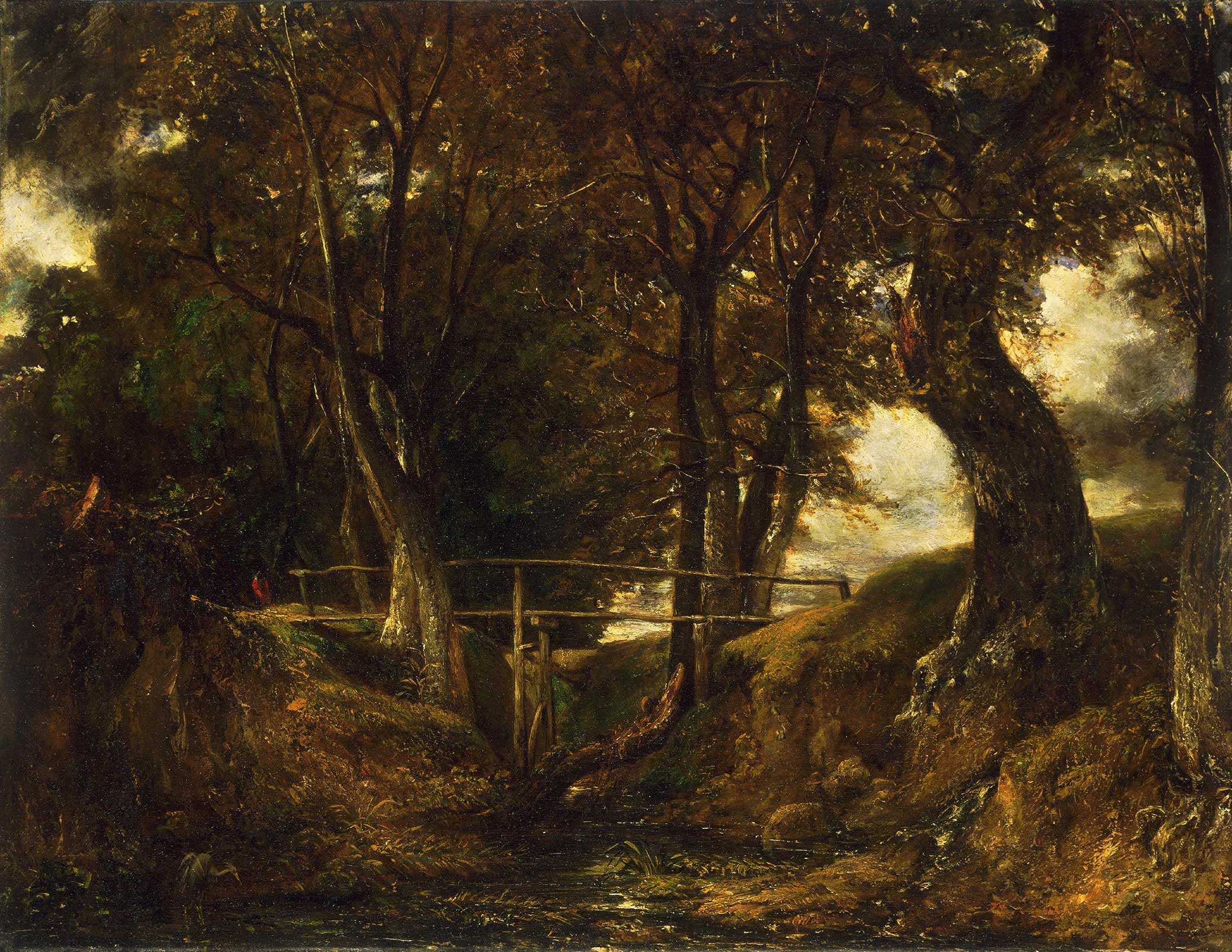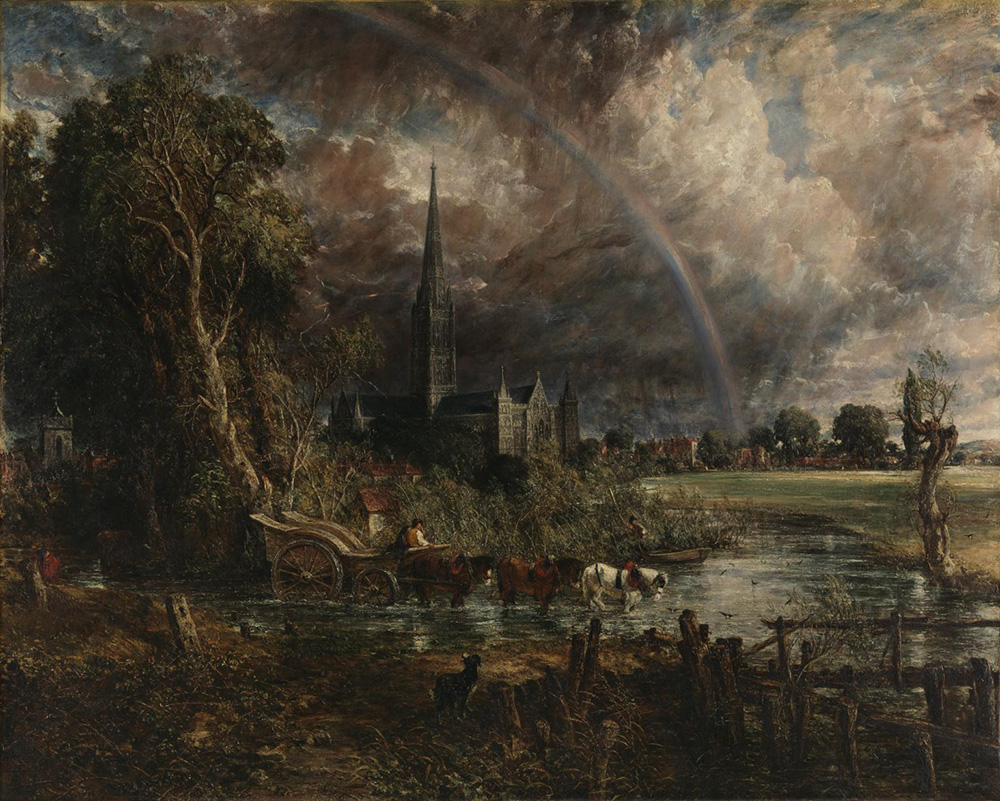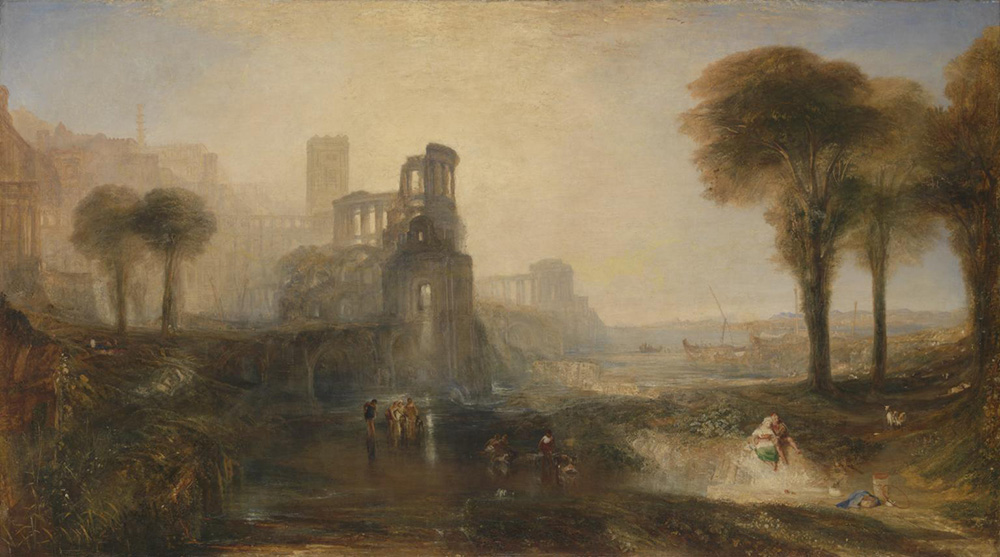
Dell at Helmingham Park, by John Constable, c. 1826. Philadelphia Museum of Art, John G. Johnson Collection, 1917.
Royal Academy exhibitions in Somerset House in the 1820s and 1830s might display between nine and twelve hundred works, oil paintings both huge and compact, watercolors florid and discreet, sculpture largely in plaster on plinths or extending out into space, architectural drawings and models. Horizontally, eight feet from the floor, a wooden molding ran around the exhibition rooms, creating a fixing for those paintings chosen to take prime position “on the line” at the summer’s exhibition. Being hung on the line was a guarantee of being noticed, or at least of being at the viewers’ eye level, while hanging above the line was grand for grand portraits, history paintings, or battle pieces lashed to a wooden support structure canted outward for the purpose. Below the line, it was hide-and-seek for the paintings and hit-or-miss for smaller pictures as they jostled for space. At the very top it was practically hopeless. The line itself was the parting of the waters, which remained a determined horizontal rarely to be bridged.
Pictures were selected by the Committee of Arrangement, which included three or four Royal Academicians chosen each year by their peers. In April 1830 the group comprised John Constable along with James Ward, who later dropped out through ill health; Abraham Cooper; and William Etty. The Academy secretary, Henry Howard, was also a member, and all were under the chairmanship of the new president, Sir Martin Archer Shee, the successor to Sir Thomas Lawrence, who had died in January. Pictures were paraded anonymously one by one before the committee. The selectors were a diverse group: Constable painted landscapes, Ward painted animals, Cooper painted battles, and Etty painted men and women naked. Collectively these men decided what was selected and, from those works, what was displayed. Not everything selected would necessarily be shown because space might simply run out, frustrating the committee’s choices. At the 1830 selection Constable’s own landscapes came up for assessment. He had been uncertain about what to submit this year, having written to ask his bookseller friend James Carpenter to forgo a picture, still on the easel, that Carpenter had already paid a hundred guineas for: “I have no motive whatever in asking this favor of you than that the picture be my own property and that I do it and send it to the Academy independently of all other considerations.”
It is not clear which painting this was, nor if Constable did indeed submit it, but one of his paintings that year did cause a fuss. “That’s a poor thing,” said one of the selectors as the work was shown to them. “It’s very green,” said another. Too much green was still anathema, despite the evident fact that England was (is) a green country. Two of the committee members castigated the painting, while Constable looked on, saying nothing. Finally, somebody decided, “It’s devilish bad—cross it.” The green landscape was passed to an Academy servant to have an X chalked on its back and be ejected. Constable then stood up, moved to the front, and said to the judges:
That picture was painted by me. I had a notion that some of you didn’t like my work, and this is pretty convincing proof. I am very much obliged to you.
Consternation; he had trapped the tormenting clique. “Dear, dear,” said the president, wringing his hands and casting about in embarrassment. “Dear, dear,” Shee said, “how come that picture is amongst the outsiders? Bring it back; it must be admitted, of course.”
“No! It must not! Out it goes,” Constable demanded, and walked out.
Water Meadows Near Salisbury is a mild-mannered picture, one of modest size (18 inches high), simple construction, and minimal incident: three horizontals, a breeze, the flowing river, one willow leaning slightly more to the right than the others, and a crow in the meadow beyond. We cannot rule out the thought that Constable submitted it for the exhibition precisely so that it would be called into question and rejected. After such a long, trying, and debilitating wait to become an Academician, he had successfully drawn his fellow artists’ fire, spiked their guns, and as far as possible opened their eyes.
Hanging the annual exhibition was a process in which chaos and order ran arm-in-arm. Carpenters, porters, upholsterers, scaffolders, men up ladders with ropes and pulleys, all under the committee’s guidance, saying up a bit, down a bit, right or left a bit, and arguing about what goes next to which, as the jigsaw puzzle took shape. And the hubbub of lifting and calling and sawing and hammering, punctuated by crashes when something was dropped. “It would amuse you much could you know how I am beset,” Constable told his friend Charles Leslie during the course of hanging the 1830 show, with its “mob of portraits.” To Carpenter he complained “Everyone who can or cannot paint a head thinks himself equal to fill the shoes of Lawrence.” To Leslie he added: “I have earls, dukes, poets, and even royalty at my [feet] (all painted on canvas of course).” By his own account it seems that he was the only one usefully getting on with the job: “On the whole I witness a melancholy display of the selfishness of our profession. I only have Ward to help me ‘hang’—and he is half silly.” The display of his own paintings that survived the selection, a gloomy and introspective Helmingham Dell and a more typical Hampstead Heath, were “plaguing me exceedingly,” and on top of that he had to sort out an artist who complained that his painting was badly hung, and was making a fuss about it downstairs.

Constable made a dismal sight around the Academy, dressed in black. His waistcoat was black, his gloves were black, even his silk handkerchief was black, but this was nothing new for him; his mourning for his wife, Maria, who died in 1827, was little different to his normal garb. The unremittingly miserable Helmingham Dell, a subject to which he had reverted time and again since 1800, may well have been the cause of his “plaguing.” Indeed, it was picked on by the Morning Chronicle critic, who alluded to Constable’s recent financial windfall of inheritance from Maria’s father, Charles Bicknell (ignoring the loss of his wife). Echoing the Irish painter Francis Danby’s assertion that the Academy had elected him for his money, the critic described Constable as:
certainly not improved in art as he has in fortune, to which latter he entirely owes the obsequiousness of the Academy, and the long struggled-for R.A. Though not without great merits, much impaired by silly affectation, and various clumsy attempts at singularity, he, as a painter, falls far short of calcott and lee in their respective excellencies—most of all in the charms of poetry and good taste.
The following year Constable was on the Committee of Arrangement once more, now with Henry Bone and Charles Eastlake. There were the usual tense arguments during hanging, one of which overflowed into a bitter row between J.M.W. Turner and Constable. Critics focused their attention on two paintings in particular: Turner’s Caligula’s Palace and Bridge and Constable’s Salisbury Cathedral from the Meadows. “Fire and water” was the description from the Literary Gazette: “If Mr. Turner and Mr. Constable were professors of geology, instead of painting, the first would certainly be a Plutonist, the second a Neptunist…the one all heat, the other all humidity.” Other critics wrote of Constable’s “coarse vulgar imitation” and Turner’s “freaks and follies”; and “Turner’s fire and Constable’s rain.” The pair were being harnessed together like a pair of mettlesome carriage horses of opposed temperaments, perceived as equals and opposites. “Turner is admirable,” wrote the Athenaeum, “Constable is Constable.”

As an acknowledgment of the slow march of time, and the relay of genius that is its heir, Constable paid twelve guineas at Christie’s in June 1830 for the paint-smeared wooden palette used by Joshua Reynolds. This had been given by Reynolds to the young George Beaumont, then bequeathed by Beaumont to Sir Thomas Lawrence, and at Lawrence’s sale bought by John Constable and presented by him to the Royal Academy. “The president and council received this liberal and interesting gift with great satisfaction,” the Academy minutes recorded. There is a sense that in 1830 and 1831 Constable was reassessing himself and considering the history of art and his place within it. Would he teach? Would he write? He was a fine writer, and he knew it; his friend Reverend John Fisher had known it also, and had encouraged his friend to write about art for publication:
You are in possession of some very valuable and original matter on the subject of painting, particularly on the Poetry of the Art. I should be very sad to see this seed sown on some unvisited field where it would blossom in forgetfulness: while some thieving author, like a sparrow, would fly off with a sample and take the credit from you…Pray do not forget to put together the history of your life and opinions with as many of your remarks on men and manners as occur to you. Set about it immediately.
Constable more or less declined this advice, though he did seriously consider writing a life of Sir George Beaumont: “I must take care of being an author, it is quite enough to be a painter,” he would say later.
He did, however, write some paragraphs about Michelangelo’s bas-relief The Virgin and Child with the Infant St. John and submitted it to the Athenaeum. Beaumont had bought the marble in Rome in 1822 and installed it in his Grosvenor Square picture gallery. He bequeathed it to the Academy: “One of the most beautiful works of art in existence,” Constable wrote of it, “a subject…which of all others awakens our sympathies and embraces the most lovely and amiable feelings.” He will have noticed the sudden movement depicted in the marble, an event that he might see among his children every day at home: the child Jesus is alarmed at a gesture of offering (of a bird?) by his cousin John the Baptist. In wandering, fluid penwork, Constable made a small sketch of the marble, dated July 1, 1830, probably from memory, as he has not remembered the pose of Jesus correctly. Saying little else about it as a work of art, he restricts himself to its discovery, price, and provenance, and with a curatorial eye describes the way it was lit in the Academy’s Council Room:
In this favorable situation the light falls from the left, showing the more finished parts to advantage, and causing those less perfect to become masses of shadow, having at a distance all the effect of a rich picture in chiaroscuro.
The subject of chiaroscuro had driven Constable for decades, certainly since he met the artist John Cranch and began briefly to paint dark, soupy landscapes under his influence. One of the books on Cranch’s “Painter’s Reading” list, written out for Constable in 1796, was Count Algarotti’s Essay on Painting, published in English in 1764. In his bachelor evenings alone in his rooms in London, Constable will have read this and thought about “the rationale of light and shade,” as Algarotti put it, “and the nature of that chiaroscuro, by which…the various forms of things are distinguished.” In Algarotti, Constable perhaps saw the word chiaroscuro in print for the first time and was intrigued by it and its meaning, for the word and its purpose followed him thereafter.
Michelangelo may also have been introduced to him at this time; Michelangelo who, as Algarotti expressed it, “was a perfect stranger to all manner of gracefulness. But he was learned, profound, severe, bold in his postures, and the first that introduced the terrible into painting.” For Constable, early seeds sprang up late, but not too late, for in the 1830s he was able to redirect the energy and emotion he had fed into loving and caring for Maria into the widening of the boundaries of the expression of his art. There is a sonnet by Constable, written in 1835, that may be a fragment of his consideration of new directions. The fourteen lines in praise of Wordsworth, “Thou second Milton!” carry within them their own chiaroscuro, expressed through the gloom of Constable’s present vision. The sonnet ends:
Nor let us dread that this proud land is doomed
To yield to violent men her Church or Laws,
While lays like thine are framed to glad the strong
And give the lowly surest hope from wrong.
Constable had a high sense of justice, framed by his forlorn hope for the continuation of political status quo, which in the early 1830s was severely rocked by Catholic emancipation and the passing of the Reform Bill. His sense of justice and his search for the truth, however he saw them, manifested themselves in what he considered to be his duty to assert the beauty and form of the world around him, and to broadcast it through his work. Constable’s response to his own feared impending “ruin” was to set in motion the creation and production of mezzotint engravings of his paintings in what he came to publish as his English Landscape series. “Set about it immediately,” Fisher had advised his friend: “life slips.”
From John Constable: A Portrait by James Hamilton, published by Pegasus Books. Copyright © 2022 by James Hamilton. All rights reserved.
